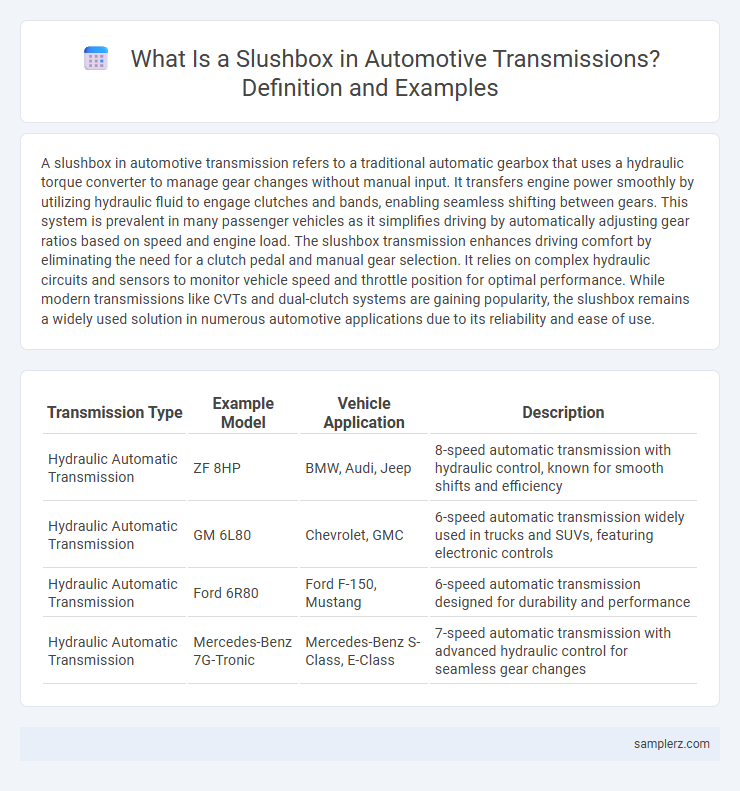A slushbox in automotive transmission refers to a traditional automatic gearbox that uses a hydraulic torque converter to manage gear changes without manual input. It transfers engine power smoothly by utilizing hydraulic fluid to engage clutches and bands, enabling seamless shifting between gears. This system is prevalent in many passenger vehicles as it simplifies driving by automatically adjusting gear ratios based on speed and engine load. The slushbox transmission enhances driving comfort by eliminating the need for a clutch pedal and manual gear selection. It relies on complex hydraulic circuits and sensors to monitor vehicle speed and throttle position for optimal performance. While modern transmissions like CVTs and dual-clutch systems are gaining popularity, the slushbox remains a widely used solution in numerous automotive applications due to its reliability and ease of use.
Table of Comparison
| Transmission Type | Example Model | Vehicle Application | Description |
|---|---|---|---|
| Hydraulic Automatic Transmission | ZF 8HP | BMW, Audi, Jeep | 8-speed automatic transmission with hydraulic control, known for smooth shifts and efficiency |
| Hydraulic Automatic Transmission | GM 6L80 | Chevrolet, GMC | 6-speed automatic transmission widely used in trucks and SUVs, featuring electronic controls |
| Hydraulic Automatic Transmission | Ford 6R80 | Ford F-150, Mustang | 6-speed automatic transmission designed for durability and performance |
| Hydraulic Automatic Transmission | Mercedes-Benz 7G-Tronic | Mercedes-Benz S-Class, E-Class | 7-speed automatic transmission with advanced hydraulic control for seamless gear changes |
Understanding Slushbox Transmissions: Definition and Origins
Slushbox transmissions, commonly known as automatic transmissions, utilize a hydraulic torque converter to manage gear changes without manual clutch operation. Originating in the early 20th century, slushboxes revolutionized driving by simplifying vehicle control and enhancing comfort. Their design eliminates the need for a manual clutch, relying on fluid dynamics to transfer engine power smoothly to the transmission system.
Key Features That Define a Slushbox Transmission
A slushbox transmission, primarily automatic, features a hydraulic torque converter that enables smooth gear shifting without manual clutch engagement. Key characteristics include seamless gear transitions, reduced driver input, and enhanced driving comfort, especially in stop-and-go traffic. Its robust fluid coupling design provides efficient power transfer and minimizes drivetrain shock during acceleration and deceleration.
Historical Development of Slushbox Automatics
The historical development of slushbox automatics began in the 1940s with General Motors introducing the Hydra-Matic, the first mass-produced fully automatic transmission that eliminated the need for manual gear shifting. This innovation utilized a fluid coupling mechanism, or "slushbox," to smoothly transfer engine power without a direct mechanical connection, drastically improving driver convenience. Over subsequent decades, advancements in hydraulic controls and electronic sensors refined slushbox systems, optimizing fuel efficiency and shift quality in modern automatic transmissions.
Notable Examples of Slushbox Transmissions in Classic Cars
Classic cars featuring notable slushbox transmissions include the Chevrolet Powerglide, a two-speed automatic widely used in the 1950s and 1960s for its durability and smooth shifting. Another prominent example is the Ford Cruise-O-Matic transmission, introduced in the late 1950s, offering three-speed automatic performance that enhanced driving comfort. The Chrysler TorqueFlite, famous for its robust design and efficient operation, became a staple in many Mopar vehicles from the 1950s through the 1970s.
Popular Vehicles Equipped with Slushbox Transmissions
Popular vehicles equipped with slushbox transmissions include the Toyota Camry, Honda Accord, Ford F-150, and Chevrolet Silverado, all known for their reliable automatic gear shifting systems. These slushbox transmissions enhance driving comfort by providing smooth and effortless gear changes without manual input. Slushbox technology is commonly found in sedans, trucks, and SUVs, demonstrating its versatility across various automotive segments.
Advantages and Drawbacks of Slushbox Systems
Slushbox transmissions, also known as automatic gearboxes, offer the advantage of smooth gear shifts and ease of use by eliminating the need for manual clutch operation, enhancing driving comfort especially in stop-and-go traffic. They typically reduce driver fatigue and improve safety, but their complex hydraulic systems can lead to higher maintenance costs and decreased fuel efficiency compared to manual transmissions. Additionally, slushbox systems may experience delayed acceleration response and less control over gear selection, which can be a drawback for performance-oriented drivers.
Slushbox versus Modern Automatic Transmissions
The Slushbox, an early form of automatic transmission, relies on a simple hydraulic torque converter and planetary gears but offers less efficiency and slower response compared to modern automatic transmissions. Modern automatics feature advanced electronic control units (ECUs) and multi-speed gearboxes, improving fuel economy and shift precision. These advancements result in smoother acceleration and better adaptability to driving conditions, setting modern systems apart from traditional Slushbox designs.
Signs Your Vehicle Uses a Slushbox Transmission
Slushbox transmissions, also known as automatic transmissions, can be identified by the smooth shifting between gears without a clutch pedal. Common signs your vehicle uses a slushbox include the absence of manual gear shifting, a gear selector with positions like P, R, N, D, and often noticeable delay during gear changes. Engine revs tend to rise before the transmission shifts gears, indicating the hydraulic torque converter's operation typical of slushbox systems.
Maintenance Tips for Older Slushbox Transmissions
Older slushbox transmissions require regular fluid changes using manufacturer-recommended automatic transmission fluid to prevent contamination and wear. Inspecting and replacing transmission filters ensure smooth hydraulic flow and avoid clogging that can lead to shifting issues. Paying attention to shift response and unusual noises early helps detect internal problems, preserving the longevity of the transmission system.
The Future of Slushbox Technology in the Automotive Industry
Slushbox technology in automotive transmissions is evolving with the integration of advanced electronically controlled hydraulic systems, enhancing shift precision and fuel efficiency. Emerging trends include the development of adaptive transmission algorithms and hybrid-compatible designs that optimize performance across various driving conditions. Future slushbox systems are expected to contribute to smoother ride experiences while supporting the shift toward electrification and autonomous vehicles.

example of slushbox in transmission Infographic
 samplerz.com
samplerz.com